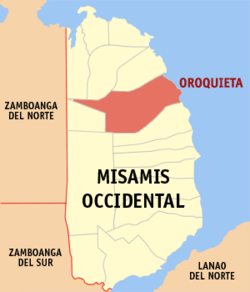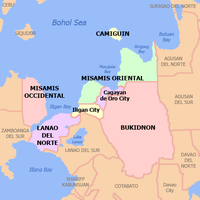Oroquieta: Difference between revisions
122.3.183.16 (talk) No edit summary |
203.111.232.210 (talk) No edit summary |
||
| Line 47: | Line 47: | ||
|government_type = City Legislative Council |
|government_type = City Legislative Council |
||
|leader_title1 = Mayor |
|leader_title1 = Mayor |
||
|leader_name1 = Jason P. Almonte ([[ |
|leader_name1 = Jason P. Almonte ([[Liberal Party]]) |
||
|leader_title2 = Vice-Mayor |
|leader_title2 = Vice-Mayor |
||
|leader_name2 = Harry J. Guantero ([[ |
|leader_name2 = Harry J. Guantero ([[Liberal Party]]) |
||
|leader_title3 = [[Sangguniang Panlungsod]] |
|leader_title3 = [[Sangguniang Panlungsod]] |
||
|leader_name3 = {{Collapsible list |
|leader_name3 = {{Collapsible list |
||
Revision as of 08:25, 21 March 2013
City of Oroquieta Dakbayan sa Oroquieta Lungsod ng Oroquieta | |
|---|---|
City | |
 Map of Misamis Occidental showing the location of Oroquieta | |
| Country | Philippines |
| Island | Mindanao |
| Class | 4th Class City |
| Province | Misamis Occidental |
| Barrios or Barangays | 47 |
| Government | |
| • Type | City Legislative Council |
| • Mayor | Jason P. Almonte (Liberal Party) |
| • Vice-Mayor | Harry J. Guantero (Liberal Party) |
| • Sangguniang Panlungsod | |
| Population (2010) | |
• Total | 68,945 |
| • Demonym | Oroquietanon |
| • Language(s) | Cebuano Filipino English |
| Time zone | UTC+8 (PST) |
| ZIP Code[1] | 07207 |
| Ecclesiastical Province | Archdiocese of Ozamis |
| Patron Saint | Our Lady of Holy Rosary |
| Diocesan Head | Most Rev. Fr. Jesus Dosado |
| Website | Oroquieta City Official Government website |
Oroquieta is a city in the Philippines. It is the capital city of the province of Misamis Occidental. According to the 2010 census, it has a population of 68,945 people.
Etymology
Some sources reveal that the town got its name from a famous barrio in Spain where Father Toas Tomas Casado, the first parish priest here, and General Domingo Mariones y Murillo, a hero in the battle of Oroquieta was born.
History
Layawan was the oldest name of Oroquieta, which was the barrio in the province of Misamis since 1861 until 1879. The early settlers then of the barrio were Boholano peddlers. They found so many stray animals along the river, thus they named the place Layawan, which means a place of stray animals. A little later, Misamis was divided into two provinces, Misamis Occidental and Oriental. Then in 1880, Layawan changed its name into Oroquieta when it became a town. Some sources revealed that the town got its name from a famous barrio in Spain where Father Toas Tomas Casado, the first parish priest here and General Domingo Mariones y Murillo, a hero in the battle of Oroquieta, were born.
Another version is that Oroquieta had derived its name from the word ‘ORO’ and ‘KITA’. The early inhabitants then had found gold along the river. Thus, the name ‘ORO’ which means Gold and ‘QUITA’ or ‘KITA’ which means to find.
Oroquieta became the capital (cabecera) on January 6, 1930.
Layawan river
Many years had passed; Oroquieta progressed by leaps and bounds until finally it became the capital town (cabecera) on January 6, 1930. As capital town, people of various neighboring provinces came and inhabited in the place where they earn their living through fishing, farming, merchandising and other forms of businesses. Soon afterwards its income increased simultaneously with increase in population.
It is worthy to note that sometime in 1942, Oroquieta was made the capital of the free Philippines by the guerillas. (Personal interview with the late Atty. Vicente Blanco, Municipal Mayor during the Japanese Occupation)
It must be remembered that during this time the late President Manuel L. Quezon together with the late Sergio Osmeña, Sr., a bodyguard and Major Manuel Nieto, Sr. landed in Oroquieta after their evacuation from Corregidor to Australia.
The seat of government of the Free Philippines then was the Capitol. The Free Philippine Government was then issuing Misamis Occidental emergency notes. Late President Quezon, upon knowing that Oroquieta was made a capital of the Free Philippines and that the town was issuing emergency notes, authorized the Printing of the Mindanao emergency note.
Another noteworthy incident during the Japanese occupation was the visit of the former President of the Philippines, Ferdinand E. Marcos and Major Manzano to Oroquieta. That time, the Commanding General of Mindanao was the late Col Wendell Fertig.
Oroquieta was created a City under R.A. 5518 and inaugurated as a chartered city on January 1, 1970. The charter converting the municipality of Oroquieta into a city are signed by President Marcos on June 25, 1969 in the presence of the then City Mayor, the late Ciriaco C. Pastrano, with the newly elected councilors and other city officials.
Geography
Oroquieta City is bounded on the south by Aloran and the north by Lopez Jaena. On the eastern side is Iligan Bay, with Concepcion on the southwest and Sapang Dalaga on the northwest. Lowland plains and coastal lowlands are located in the City’s eastern side while highlands and mountains tower over its western side. The City occupies roughly 26,393 hectares, the majority of which comprises the mountain barangays of Mialen, Toliyok and Sebucal, averaging less than a thousand hectares per Barangay, the 47 barangays of the City outsize its urbanized counterparts.
Administrative divisions
Oroquieta City is politically subdivided into 47 barangays.
|
|
|
See also
Notes
- ^ "Oroquieta in Misamis ZIP Codes in the Philippines". 2010-09-26. Retrieved 2009-03-29.


